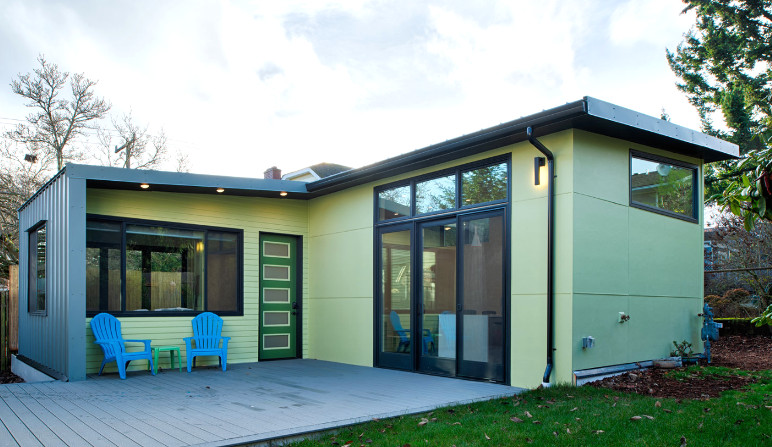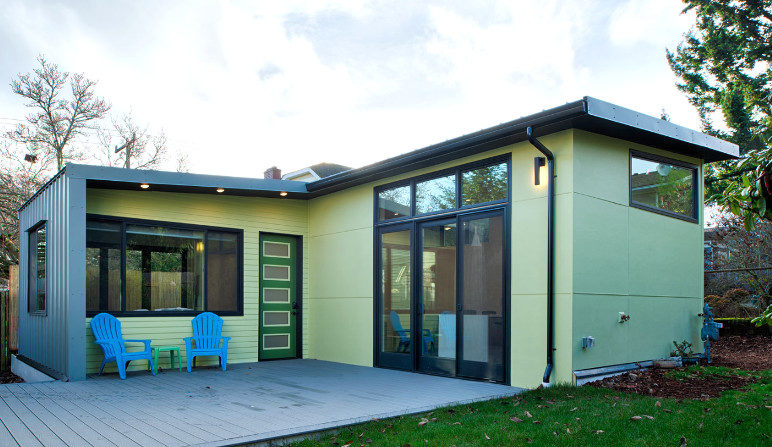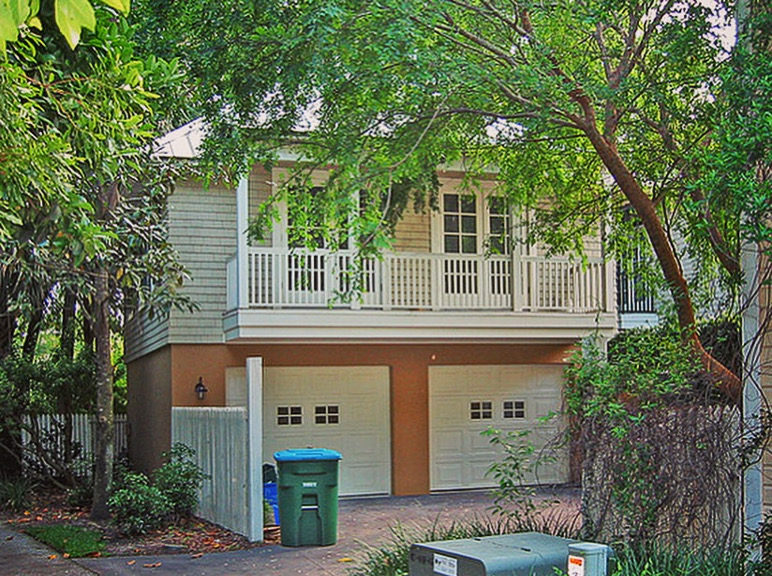If you’re lucky enough to be a Cascadian homeowner, you’ve probably toyed with the idea of installing a mother-in-law apartment or backyard cottage at your place. If you’ve gone as far as to explore what would be required, you may have slammed straight into an accessory dwelling unit (ADU) buster: your city’s fees. In Washington, for example, depending on what city you live in, so-called impact fees alone might total as much as $9,000.
North American cities routinely charge homebuilders impact fees to help pay for schools, parks, roads, or public services. At the same time, many of these cities face an unprecedented housing affordability squeeze, and, as Sightline has written previously, impact fees only make things worse by adding cost to new homes.
Over recent years, ADUs—wonk-speak for granny flats, basement apartments, backyard cottages, and the like—have garnered increasing attention as a green, relatively affordable housing choice. Still, many jurisdictions burden ADUs with impact fees. Local and state lawmakers can help unleash ADU construction by eliminating them. Here’s why:
Impact fees can hold back ADU construction
The table below shows total impact fees charged on ADUs by 13 Washington cities, including Everett, Kent, and Spokane. Totals vary among and within cities, depending on attributes like bedroom count. Seventeen other cities surveyed, including Bellevue, Tacoma, and Yakima, exempt ADUs from impact fees (see endnote). (Most jurisdictions also collect an array of utility fees not reflected here. For example, for backyard cottages King County collects a $7,000 sewer capacity charge in payments over 15 years.)
 Builders either pass on fees to renters or buyers, or, if they believe that renters and buyers can’t afford those hikes, they don’t pursue construction in the first place—and that, too, drives up rents and prices by squeezing the supply of homes. For typical homeowners with limited budgets, the decision to build an ADU is likely more straightforward: the more fees raise the cost, the less likely they’ll do it.
Builders either pass on fees to renters or buyers, or, if they believe that renters and buyers can’t afford those hikes, they don’t pursue construction in the first place—and that, too, drives up rents and prices by squeezing the supply of homes. For typical homeowners with limited budgets, the decision to build an ADU is likely more straightforward: the more fees raise the cost, the less likely they’ll do it.
Homeowners commonly cite development cost as a key deterrent to taking on an ADU project. Portland, Oregon, provides a telling demonstration of how costly fees can suppress ADUs: in 2010, it waived system development charges of up to $16,000 and ADU permit applications took off.
A few Washington jurisdictions have taken similar steps. In 2017, Renton halved its ADU permitting fees—including park and transportation impact fees—knocking down the fee total by about $11,000. Initial results are promising, albeit modest: in 2018 Renton saw five ADU permit applications, matching the number it had over the seven previous years combined.
In 2018, Bellingham cut park impact fees by $1,000 and eliminated them for ADUs built inside an existing house. Permit applications have ticked up but it’s too soon to draw conclusions. Also last year, Clark County lowered impact fees on ADUs to one quarter of the fees it imposes on multi-family homes. Several cities in Oregon have recently reduced ADU impact fees as well.
Impact fees are especially hard on modest, low-cost ADUs
ADU price tags vary widely—a bare-bones renovation to a plumbed basement might be $20,000, while a high-end backyard cottage could run $300,000 or more—but most are far cheaper to build than other home types. Consequently, prospective ADU projects are more vulnerable to death by fee. As with any fee, an impact fee creates a stronger disincentive the smaller the budget, because it piles on a larger percentage cost increase. Most cities temper that effect by charging lower impact fees for ADUs than for single-family houses, while three of the cities in our list—Bothell, Cheney, and Everett—scale their fees according to ADU size.
Heightening the sensitivity to added cost, ADUs are usually built by people who are not real estate development professionals. Coming up with the money to pay for ADU construction is a big stretch for most homeowners, and fees make it that much more challenging. Cash-strapped owners trying to create low-budget ADUs take it on the chin the hardest, and when impact fees force them to take a pass, communities lose what they most need: low-rent homes.
ADUs on the modest side of the cost spectrum provide “naturally occurring affordable housing”—that is, homes that are relatively affordable without any subsidy. By charging impact fees that stymie production of these homes, cities widen their affordability gap. That outcome increases the need for publicly-funded subsidies to support the people who fall into the gap because they can no longer afford what the private housing market offers. Impact fees on ADUs rob Peter to pay Paul.
Impact fees on ADUs—as with any housing—undermine equity and sustainability
Charging impact fees on any urban infill homes—including ADUs—undermines efforts to create green, equitable compact neighborhoods. First, when impact fees penalize homebuilding in urban centers, they push builders away to find better opportunities farther out. The result is more sprawl and climate pollution.
Second, impact fees impose what’s in effect an extra price of admission on newcomers, buttressing the invisible walls of economic exclusion that plague ever-expanding portions of cities such as Seattle and Portland. Existing homeowners get off free, while the fees, by causing higher rents, inflict the most harm on those with the least housing security: tenants.
Impact fees on ADUs penalize efficient use of existing public services
Most public services are cheaper on a per-capita basis in compact neighborhoods, mainly because everything is closer together—shorter roads cost less. Compared with a house in a new subdivision that needs a host of brand new infrastructure to support it, an ADU built alongside an existing house can share existing roads, sidewalks, transit, utilities, and services.
Alone among the cities we surveyed, Spokane’s road impact fee structure accounts for this spatial efficiency. The city charges just $106 for ADUs in it’s high-density core where transit is robust, but up to $1,000 for locations away from the core. In fact, this approach makes even more sense at the regional scale: charge impact fees in undeveloped areas, but not in cities.
Eliminate impact fees on ADUs first; on all urban homebuilding next?
If cities want to reap the benefits of more granny flats and backyard cottages, one action they can take is to nix impact fees. The low-budget, do-it-yourself nature of ADU construction makes it particularly vulnerable to added costs that can deter owners from taking the leap.
Over half of the Washington cities for which we found data already exempt ADUs from impact fees, illustrating that many jurisdictions already recognize the problem. The Washington legislature is currently considering a bill to stimulate ADU construction. It includes a provision limiting impact fees.
Growing momentum to eliminate impact fees on ADUs may also raise awareness that impact fees sabotage other forms of homebuilding too. When we know that adding homes to existing urban areas is a critical strategy for improving housing affordability, curbing sprawl, and cutting climate pollution, treating homebuilding as a negative “impact” that should be fined is like shooting ourselves in the foot.
Notes
Washington cities from our survey that exempt ADUs from impact fees: Bellevue, Bremerton, Covington, Edmonds, Granite Falls, Issaquah, Kirkland, Lynnwood, Marysville, Mercer Island, Redmond, Sammamish, Seattle, Spokane Valley, Tacoma, Vancouver, and Yakima.
For detailed impact fee information on all the cities we surveyed, see this google spreadsheet.
Acknowledgements
Thank you to Sightline’s all-star research associate Nisma Gabobe who did the research heavy lifting for this article.
Thank you to Bellingham city planner Christopher Koch, who generously shared the impact fee data he dug up on 17 cities. Mr. Koch did not contribute to the writing of this article or influence the views expressed in it.











Jeremy Grimm
Dan, if you eliminate impact fees, where does local government generate the revenue to expand services, like parks, roads, utilities, schools, fire and police? General funds typically only cover operational cost and growth does cost in the form of added demand for these services.
Dan Bertolet
My take is that “growth pays for growth” is a flawed rationale. When people move to a city, what’s fair is they pay the same taxes as current residents to cover services, including operations and expansions. Why should they pay an extra entry fee on top of that? I go into it deeper here:
https://www.sightline.org/2017/09/28/impact-fees-an-urban-planning-zombie-in-need-of-slaying/
Also, I don’t think it’s defensible to say we should keep using a source of funding—even though it exacerbates what is arguably our most urgent urban planning challenge (affordable housing)—just because it’s hard to find another, less damaging revenue source.
Doug Klotz
In Oregon we have a greater problem: Property tax limitations that forbid counties from taxing properties based on their assessed value, instead basing taxes on the value in 1994 plus a yearly increase. So jurisdictions instituted System Development Charges, to essentially make newcomers pay for upgrades that existing residents should also be paying for!
Jeremy Grimm
So based on this line of thought, if I’ve lived in a community for a generation and the residents have taxed themselves to develop great amenities, facilities and quality of life, and new residents are attracted to this community due to the great services and amenities, but their arrival clogs the roads, parks and degrades the level of service in the community, why should longtime taxpayers have to pay to expand facilities for newcomers? These people are attracted to facilities that longtime residents have all ready paid for. General fund dollars typically only support operations, not expansion of facilities. It’s a bit of a bait and switch: you like my community with all the amenities and the current level of service, but your arrival will undoubtedly add demand to these services and without expansion, a lowered level of service will result. So, what you are saying is that long time residents should pay for/subsidize the cost of newcomers? Impact fees help to ensure those that are creating the increased demand pay their fair share.
SG
Sounds like you’ve invested your resources in developing a bad party
https://www.strongtowns.org/journal/2017/6/26/the-party-analogy
Dan Bertolet
Jeremy –
Your line of thought leads to some odd scenarios:
If you leave a city you’ve lived in for years, does that city owe you a cash out payment for your investment in their facilities so you can pay the admission fee to the city you’re moving to?
Are babies born in a city also freeloaders who should pay extra impact fees?
In any case, my understanding is that most service expansions (e.g. a new sewage treatment plant) are paid for with long term bonds. In a typical city you’ll have multiple projects like this ongoing with overlapping time periods, so in the end it all pretty much smears out and everyone pays about the same as they come and go, and in effect it’s like another utility bill paid by rate. In other words, there’s no justification for a extra first time payment. Do I have something wrong?
BK
Thanks for the great coverage and analysis Dan.
I realize this may be pushing the envelope beyond “let’s make existing laws less bad” toward “let’s make laws affirmatively good,” but I’m struck by the case for a reverse impact fee for ADUs (or in effect incentive) within the envelope of an existing house.
Such a home would be accommodating a household in a net new domicile with no more impermeable surface, no tree removal, re-use of the materials of the existing envelope and lots of embodied energy, etc…
You could look at that in relation to the probability and implications the household would consume an existing domicile or a newly built one. The over-under impact is probably favorable to ADUs. (Put another way, using an extreme case: if we got every bit of housing we needed through sub dividing existing buildings versus net new construction, the former is clearly better!)
Dan Bertolet
Absolutely! In fact, I would argue that any form of urban infill housing should get a reverse impact fee.
BK
We’re in a legacy zoning split-lot infill …check please! (Kidding – using less land was reward enough for us to do it 100% voluntarily, but totally agree that it would be great to incent people on the fence / on the margin,)
YA
Hello Dan,
Where does your $12,000 figure for King County’s sewer capacity charge come from? The link you made to the KC website shows it being $64.50 per residential customer equivalent (RCE) per month.
Dan Bertolet
Thanks for flagging. Based on a prior private communication with King County and the City of Seattle, as we understood it, the sewer treatment capacity fee is charged monthly for a period of 15 years, resulting in approx. $12,000. However, we have since learned from a subsequent private communication with King County that ADUs are charged at 0.6 of the rate charged to single family homes, resulting in approx. $7,000 over 15 years. The article is now updated to reflect that.
TO
Okay, that’s nice you corrected it, but why you don’t mention the 15 year time span in your article? The $7,000 is not charged up front, which your article implies.
Dan Bertolet
Fair enough! Updated.
Kim Spencer
My City is charging me 6449 .00 dollars up frount in impact fees for my ADU. and My mothers house has existed on the property for 75 years but because they did not have adu back when we built a main house on the property the change the use to storage and now want me to pay impact fees up front cant even make payments on it .